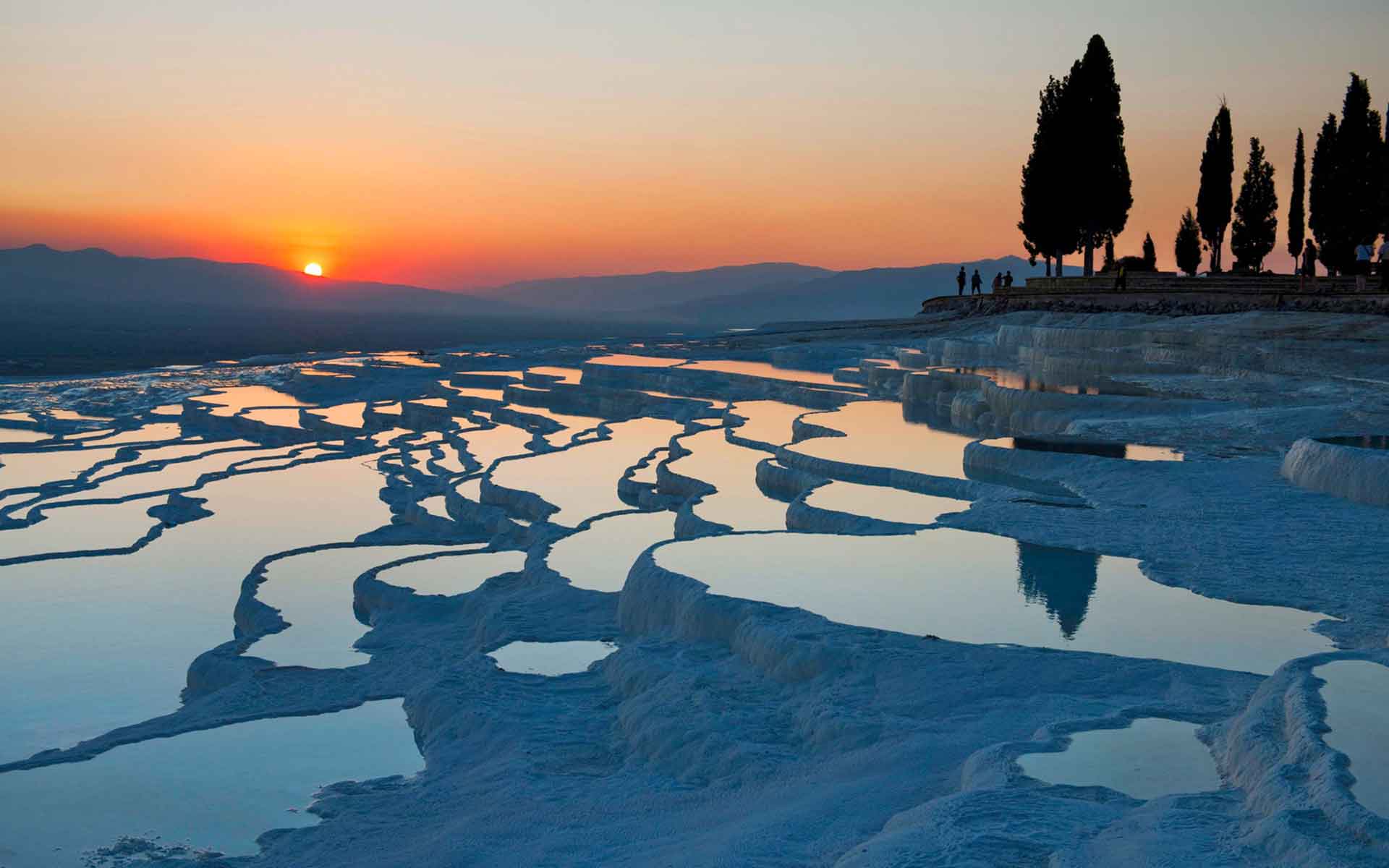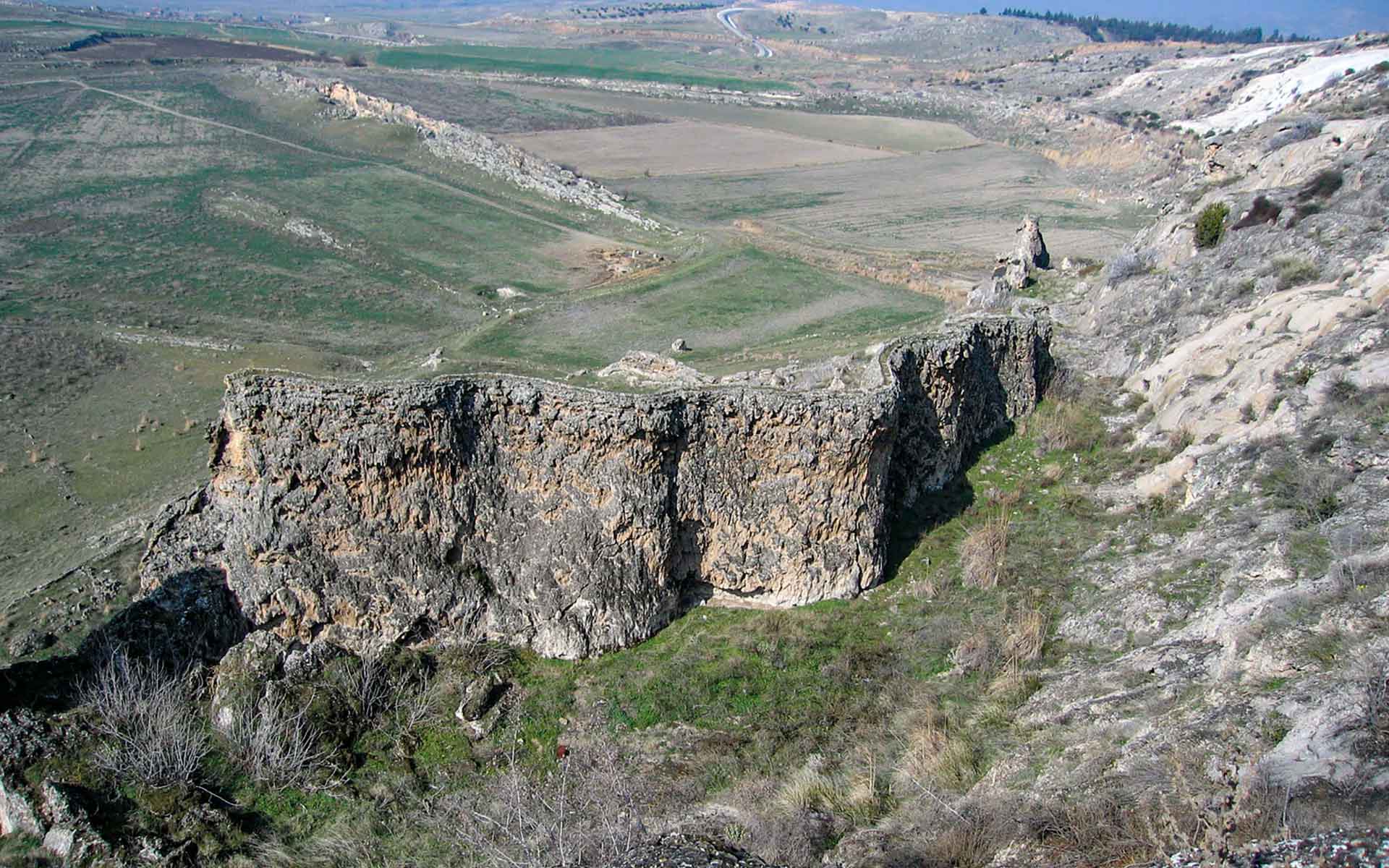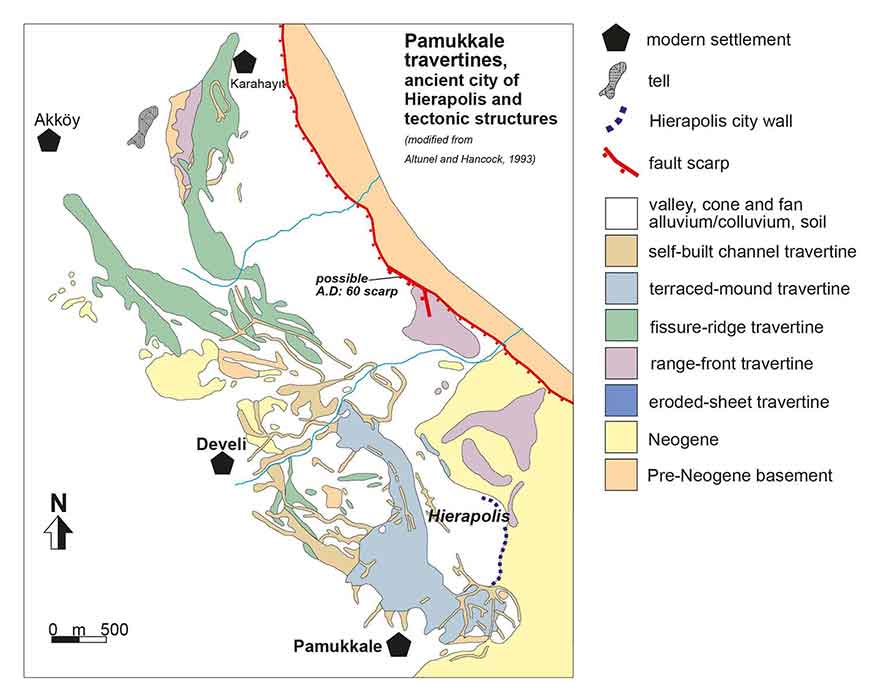
Terrace pools at sunset in Pamukkale, (Photo from Archive of Ministry of Culture and Tourism).
Geological Period
Middle Pleistocene – Holocene
Main geological interest
Geomorphology and active geological processes
Stratigraphy and sedimentology
Location
Pamukkale, Denizli, Turkey.
37°55’25.0″N, 29°07’15.0″E
Terrace pools at sunset in Pamukkale, (Photo from Archive of Ministry of Culture and Tourism).
A GLOBALLY OUTSTANDING TYPE SITE WITH A HIGH DIVERSITY OF TRAVERTINE FEATURES AND PROCESSES ON AN ACTIVE FAULT.
The Pamukkale travertines are a key location for ‘travitonics’ embracing all aspects of travertine tectonics. This region includes five of six morphologies suggested for travertine deposits accompanied with active faults; these include terrace-mound, fissure-ridge, range-front, eroded-sheet and self-built channel travertine (Hancock et al., 1999). The dateable character of travertines by the U-series method allows the determination of ancient tectonic activity such as the destruction of the ancient city of Hierapolis. The travertines reveal how seismicity affected the ancient Hellenistic to Byzantine civilizations, and modern urban develoments (Kumsar et al., 2016).
- Geological description
Pamukkale is a globally important type locality for travertine (Altunel and Hancock, 1993; Altunel and D’Andria, 2019). Pamukkale means “cotton castle” in Turkish for its snow-white colored travertine terraces. Calcium-carbonate-laden geothermal waters with temperatures higher than 35 °C sourced from a fault scarp have, since the middle Pleistocene, created an outstanding natural landscape. The groundwater circulation through limestone bedrock is a key component in the supersaturation of hot waters with calcite (Kele et al., 2011). There is a high diversity of step-like terraces with pools (terrace-mounds), fissure ridges, and individual channel-type travertine formations and related hot springs (Hancock et al., 1999). These have attracted different civilizations over thousands of years, and as a result, while the ancient city of Hierapolis was established next to it, the Pamukkale travertine is still the most visited international destination point in Turkey (Scoon, 2021). Several destructive earthquakes damaged ancient structures in Hierapolis by rupturing along an active fault, and there is a long record of historical seismicity in the area (Kumsar et al., 2016). Therefore, it is long-time voiced that the Hierapolis ancient city can provide a broad basis to realize the relationship between seismic damage and active faulting
- Scientific research and tradition
Pamukkale has been the subject of much research into travertine formation and paleoseismicity, and of many documentaries. Its photos are used for publication covers in many disciplines; its cultural heritage has been linked to the unique travertine deposits.
- Reference
Altunel, E. and D’Andria, F. (2019) ‘Pamukkale Travertines: A Natural and Cultural Monument in the World Heritage List’, in C. Kuzucuoğlu, A. Çiner, and N. Kazancı (eds) Landscapes and Landforms of Turkey. Cham: Springer International Publishing (World Geomorphological Landscapes), pp. 219–229. Available at: https://doi.org/10.1007/978-3-030-03515-0_8.
Altunel, E. and Hancock, P.L. (1993) ‘Morphology and structural setting of Quaternary travertines at Pamukkale, Turkey’, Geological Journal, 28(3–4), pp. 335–346. Available at: https://doi.org/10.1002/gj.3350280312.
Hancock, P.L. et al. (1999) ‘Travitonics: using travertines in active fault studies’, Journal of Structural Geology, 21(8), pp. 903–916. Available at: https://doi.org/10.1016/S0191-8141(99)00061-9.
Kele, S. et al. (2011) ‘Stable isotope geochemical study of Pamukkale travertines: New evidences of low-temperature non-equilibrium calcite-water fractionation’, Sedimentary Geology, 238(1), pp. 191–212. Available at: https://doi.org/10.1016/j.sedgeo.2011.04.015.
Kumsar, H. et al. (2016) ‘Historical earthquakes that damaged Hierapolis and Laodikeia antique cities and their implications for earthquake potential of Denizli basin in western Turkey’, Bulletin of Engineering Geology and the Environment, 75(2), pp. 519–536. Available at: https://doi.org/10.1007/s10064-015-0791-0.
Scoon, R.N. (2021) ‘The Hierapolis-Pamukkale Archaeological and Geosite, Southwest Turkey’, in The Geotraveller. Cham, Switzerland: Springer, pp. 301–311. Available at: https://link.springer.com/chapter/10.1007/978-3-030-54693-9_14.
- Author(s)
Alper Gürbüz
Ömerhalisdemir Universitesi, Niğde, Türkiye
Mehmet Özkul
Pamukkale Universitesi, Denizli, Türkiye
Nizamettin Kazancı
Ankara University, Ankara, Turkey
Mary Lou
UNESCO-IRCK


